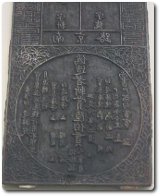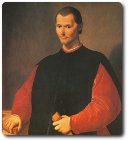Articles
- The world of Shakespeare and the Metaphysical poets 1540-1660
- British renaissance writers
- Key events
- Making sense of the tangible world
- Making sense of the intangible world
Renaissance
Changing attitudes
The thirteenth and sixteenth centuries in Europe saw a changing attitude to religion, part of a movement now known as the Renaissance (meaning re-birth) which affected many areas of life from art to exploration. Much of its impetus came from Italy, where the study of ancient Latin, and particularly Greek, manuscripts led scholars to question the ideas that the Church had for so long put forward – especially that the Roman Catholic Church was the holder of all wisdom essential for salvation.
There was a renewed interest in humanity and humanist ideas, strengthened by an influx of Eastern scholars who fled to the west, bringing with them important ancient manuscripts, when Constantinople (the modern Istanbul) fell to the invading Turks in 1453.
Printing
Information explosion
The spread of new knowledge was hugely accelerated by the invention of printing in Germany in the  mid-fifteenth century (about 1450). In England, the first printing press was set up by William Caxton in London in 1476. The impact was like that of the internet today. Printing had actually been known in China for centuries, but not in Europe. Prior to this, information, including such lengthy works as Bibles, had to be copied out by hand. This was usually done in monasteries under the supervision of the church. There were very few books available, and these were very expensive.
mid-fifteenth century (about 1450). In England, the first printing press was set up by William Caxton in London in 1476. The impact was like that of the internet today. Printing had actually been known in China for centuries, but not in Europe. Prior to this, information, including such lengthy works as Bibles, had to be copied out by hand. This was usually done in monasteries under the supervision of the church. There were very few books available, and these were very expensive.
Once material was much cheaper and easy to reproduce by printing, scholars could much more easily disseminate information. Adventurous new ideas could spread, including material attacking institutions such as the church.
Books Shakespeare read
Playwrights like Shakespeare read many printed works translated from French and Italian. They suggested the plots of his plays – for example:
-
The Decameron by Boccaccio provided Shakespeare with material for All's Well That Ends Well.
-
Sir Thomas North's translation of Plutarch's Lives of the Romans gave Shakespeare the information he needed for Julius Caesar and Antony and Cleopatra.
Advice on how to govern
Kings and courtiers began to be more aware of political theory and the need to study how to rule. One of  the most famous books published during the Renaissance in Italy was Machiavelli's The Prince. This suggested the need for rulers to be prepared to be devious. It was translated into English and certainly known in England by the time of Henry VIII.
the most famous books published during the Renaissance in Italy was Machiavelli's The Prince. This suggested the need for rulers to be prepared to be devious. It was translated into English and certainly known in England by the time of Henry VIII.
It is possible to see the Duke in Measure for Measure as devious in his treatment of Angelo and in his spying on his citizens.
The ideal Renaissance man
An aspect of court life was the idea that the ideal Renaissance man should be widely accomplished. This is reflected in Measure for Measure when, the Duke describes himself as ‘a scholar, a statesman and a soldier'. The qualities of an ideal Renaissance prince were also outlined in Hamlet:
The courtier's, soldier's, scholars' eye, tongue, sword!
Th'expectancy and rose of the fair state,
The glass of fashion and the mould of form,
Th'observed of all observers.'
Renaissance Tudors
Henry VIII and Queen Elizabeth I certainly qualified as Renaissance princes. Both:
-
Were scholars
-
Were widely read
-
Enjoyed writing poetry and music
-
Set fashions in clothes and appearance
-
Were soldiers / involved in warlike activity
-
Henry on the Field of the Cloth of Gold in France
-
Elizabeth addressing her troops at Tilbury.
-
James I was not physically attractive nor a soldier, but he certainly saw himself as a scholar. As well as writing about his belief in the ‘divine right of Kings' (see also Religious/philosophical context: Divine right of Kings) in his book Basilikon Doron, he enjoyed creating poetry, some of which was published as His Majesties Poeticall Exercises at Vacant Hours.
New areas of exploration
The Renaissance challenged boundaries in thought as well as learning.
Religious art
Previously, virtually all art in Western Europe was religious: Bibles and prayer books were illustrated with designs and figures; altar-pieces were painted with pictures of Christ and of the Madonna and Child; and imaginary portraits were made of saints, to be placed in chapels and used for devotional purposes.
However, as interest grew in areas of life not governed by the church, art began to change too.
Humanism in art
Renaissance artists started to be much more interested in the human form. Michelangelo and Leonardo da Vinci, who worked for the Pope and made superb religious works, nevertheless promoted an interest in the human figure, since they made detailed sketches of the torso, working from real models. Paintings of the Madonna now had realistic landscapes as a background, and artists began to be much more interested in exploring perspective and other techniques.
The known world extended
The Renaissance quest to make sense of the world also led to voyages of exploration. At this time there were frequent quests to find out new sea-passages to China and India, and to discover other continents. In England, some of the most famous names from the time of Shakespeare are those of explorers such as Sir Walter Raleigh or Sir Francis Drake.
Scan and go

Scan on your mobile for direct link.